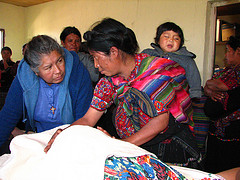2020 marks the 18th year of the Safe Motherhood Project in Guatemala, a four to five day hands-on education program for Mayan midwives who are called comadronas, Guatemalan volunteer firemen/paramedics who are called bomberos, and other healthcare workers involved in maternity care. We have now taught over 1280 students, skills helpful in managing obstetrical emergencies. We have always intended that these skills complement the traditional birthing practices of Mayan comadronas. The goal is to help reduce maternal and newborn mortality.
Fifty percent of the Guatemalan population identifies as indigenous, Maya. The majority of the Mayan population in Guatemala lives rurally and does not have easy access to health care services. While giving birth has become safer in the urban areas of Guatemala over the past twenty years due to proximity to a system of National Hospitals, giving birth rurally is still fraught with risk; hospital care is often a distance away, and maternal mortality and newborn mortality rates are much higher among the rural population in the country. Our course targets comadronas and bomberos in the rural highlands of Guatemala.
The global pandemic caused by the SARS CoV2 virus has had a huge impact on our project this year. Just before global cases of COVID 19 surged, from January 9 to January 26, Annette Borkent, RN, Ruth Brighouse, MD, and Birte Pachen, RM, travelled to Guatemala to join our Guatemalan teammates, Cenaida Juarez, project coordinator and instructor; Gloria Cotuj, comadrona and instructor; and Gaby Castellanos, nutritionist and instructor. Together we taught 15 experienced comadronas in Santiago Atitlan on Lake Atitlan in the department of Solola. All of our students were very satisfied with the course remarking how practical it was and how useful it would be to apply the skills learned in a rural home birth. We had a wonderful closing ceremony where each student received their course diploma, manual, and birthing kit of supplies. We were fortunate to use the facilities at the POWHER School, run by Salvando Madres. POWHER is an NGO that also offers courses and assistance to the comadronas of the municipality of Santiago Atitlan. We required translation assistance from Chonita one of POWHER’s instructors, as most students spoke the Mayan dialect of Tzutuil. During this time we met American and Mexican midwives volunteering at the school and also at a Casa Materna (birth house) in San Juan La Laguna, a community across the lake from Santiago. Check our facebook page, “The Safe Motherhood Project” to see videos of us in action this year.
For the second week of our sojourn we planned to teach in San Juan La Laguna, but the group requesting our course cancelled the course just days before our arrival. Always adaptable, we seized the opportunity to teach 57 school girls aged 10 to 13 years. We taught the girls about female anatomy, menstruation, teen pregnancy, and the right to say “NO” to sexual advances. Teen pregnancy is a huge problem in Guatemala. Each student was allowed to ask questions anonymously by writing her question on a piece of paper that was placed in our basket. We jumbled the pieces of paper and drew questions and provided answers. This was very successful. This type of educational project would tie in nicely with the Days for Girls project where re-usable menstrual pads and panties are provided in a kit to each adolescent girl. Unfortunately we had not budgeted for these supplies which we could have obtained for a cost from the local branch of Days for Girls.
We also took time to provide practice updates to our Guatemalan teammates and re-certify them on the various topics we teach. We often do not have time during our trips to provide continuing education to our instructors. This was a timely opportunity. We also spent time updating our manual to be more commensurate with the Guatemalan Department of Public Health health promotion materials.
Finally, we were invited by three bomberos that we had taught three years prior, to Chichicastenango, Quiche, population, 75,000. They shared stories of how valuable our course had been for them. They had been called to a number of birthing emergencies and were able to save the lives of both mothers and babies using the techniques we had taught. They wanted us to come to their city to offer a course to their bombero colleagues, which was planned for April 2020.
And then the virus struck globally and a pandemic was declared which halted our team’s activites abruptly in March…..
It is unfortunate that so many worthwhile projects have been placed “on hold” during this pandemic. We have also suspended our fundraising activites given the current uncertainty.
We have been convinced by the students we’ve taught of the value of our “hands on” teaching model. We believe this course is truly valuable and deserves to continue. This hiatus will allow us to solicit funds from larger funding agencies in addition to our usual individual donors.
We have a positive balance in the bank. While Guatemala is under curfew, there may still be useful activities our Guatemalan teammates can undertake in the next few months. It is our hope to have a broader reach with our birthing emergencies course throughout Guatemala. To do that we will need to train a larger and more geographically diverse group of instructors. We hope to have some success with larger funding agencies who share our vision.
Annette Borkent. Founder Safe Motherhood Program Guatemala



